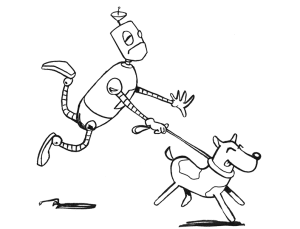Automation takes place in all industries. The threat is not limited to mechanical robots that assemble cars in large factories or prepare orders in Amazon warehouses. We see that artificial intelligence has a radical impact on all kinds of jobs. From truck drivers and tele-operators to lawyers and doctors. Robots wil take your job it seems.
When we ask the question “will robots take my job?”, we often imagine a dystopian future in which cyborgs have completely replaced humans.
What we tend to neglect in these scenarios is that technology has already taken over 90% of the jobs that humans once used to do. Before the first industrial revolution, the vast majority of people were employed in agriculture. Although we need more food than ever, only around 2% of people still work in agriculture. We didn’t end up with mass unemployment. Instead, the nature of our jobs changed radically as we shifted to a knowledge economy.

What we do see is that the speed of change is increasing. People will have to continue to adapt to keep up with this rate of technological change and to find their place between artificial intelligence, robots, 3D-printing and self-driving cars. Robots have been taking people’s jobs for decennia and they will keep doing so.
In most cases, artificial intelligence will not eliminate your work. Instead, it will help to reduce the amount of boring and repetitive tasks you have to perform on a daily basis. As such, robots will allow people to spend more time on challenges at a higher level that are more intellectually stimulating.
This will of course require a great deal of flexibility from people. It will also place a great responsibility on people to educate themselves in order to adapt quickly to changing circumstances and to address higher interpersonal, creative and innovative challenges.
Our education will have to follow the rapid changes in society. A system that was optimised to prepare workers for an industrial world does not deliver knowledge workers. With the disappearance of entry-level roles new employees will have to hit the ground running. As AI is outperforming humans at tasks like number crunching or document review, new staff in accountancy or the legal profession miss out on the valuable immersion and learning opportunities the entry-level jobs in these sectors offered.
Will robots take our job? Very likely, but it is up to us to arm ourselves against a future of uselessness.
Building on two decades of experience with over 1,250 projects in a wide range of industries. Creax is a trustworthy innovation partner.
Building on two decades of experience with over 1,250 projects in a wide range of industries, Creax is a proven innovation expert.